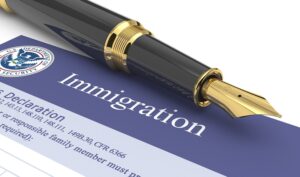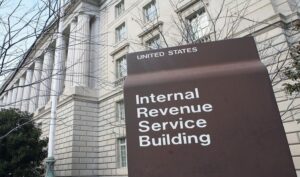
U.S. Citizenship and Immigration Services (USCIS) publishes statistics for the time it takes to process immigration benefit requests. But how accurate are USCIS processing times? We analyzed the immigration agency’s performance over time and suggest how you can get the best processing times or get answers when your case is lingering.
If you will be filing a form to request an immigration benefit such as a fiancé visa, green card, citizenship, CitizenPath provides support to streamline the application process and ensure you get good processing times from USCIS. Learn how to make the immigration process easier and more affordable.
Growing Pressure on USCIS Processing Times
The situation for the average immigration filer isn’t getting significantly better. While USCIS has made some progress on certain forms over the last few years, processing times are generally trending worse as backlog grows. The chart below illustrates the backlog problem. Over the past decade, the USCIS case backlog grew by 6,199,717 cases. That's over 189 percent.
Forms Filed and Overall Backlog (2015-2024)
The agency’s backlog grew significantly due to their work stoppage during the COVID-19 pandemic. USCIS has also struggled to execute on technology plans and staffing levels. USCIS has also implemented a fee increase in 2024 to facilitate hiring more staff to improve processing times. The situation still needs attention. For example, the backlog for family-based visa petitions (Form I-130) has more than doubled in 10 years.
Form I-130 Historical Backlog
Form N-400 Historical Processing Times
However, over the past couple of years, USCIS has made modest strides to improve their processing times on certain forms. For example, the time to adjudicate Form N-400, Application for Naturalization, has recently improved by several months.
Select any of the following forms to see a USCIS case processing timeline as well as historical charts for processing times and case backlog data:
Accuracy of USCIS Processing Times
You may notice that much of the USCIS reporting for their processing times varies significantly. The range may be significant; it can be different than other reporting on the website; and historical processing numbers don't seem consistent. Much of this is related to the way that USCIS reports their numbers. What's more, this inconsistency has also led to complaints about their transparency.
How USCIS Processes Forms
USCIS does not process all forms at a local field office. Most forms are initially filed at a lockbox. This is nothing more than a receiving location to confirm you’ve submitted the basic requirements, scan documents, and process payments. If you don’t submit everything correct, they may issue a rejection notice from here.
From the lockboxes, USCIS cases transition to a service center. This is a regional office that does the next level of processing to confirm eligibility and do some analysis of your benefit request. If you haven’t submitted all necessary supporting documents, the service center may issue you a Request for Evidence. In some cases, service centers will process the entire case. Service centers will adjudicate (make a decision) on requests such as Form I-90 (green card renewal/replacement), Form I-129F (K-1 visa petition), and I-130 (family visa petition). USCIS does their best to balance the work loads of these service centers.
Many other types of immigration benefit requests cases are then moved to USCIS field offices. The field office selected will generally be the office nearest the requester’s address. Field offices in more populous areas will typically have a larger workload, and this can affect USCIS processing times for that field office. Based on the performance of these individual locations, USCIS creates monthly reporting on their processing times.
You can check the reported USCIS processing times here.
What the Numbers Mean
USCIS processing time is defined as the number of months that have elapsed between the date USCIS received a properly filed form and the date they adjudicated (approved or denied) the form in a given six-month period. The processing time displayed on the USCIS website is the amount of time it took them to complete 80 percent of adjudicated cases over the last six months.
Submitting a thorough, well-prepared application package is one of the most effective way to mitigate delays. CitizenPath customers generally experience faster USCIS processing times than you see in this reporting. That’s because our focus in ensuring that you file a well-prepared form with all required supporting documentation to make a quick decision. Try the CitizenPath approach and get customized filing instructions with a document checklist for your situation.
Trump Effect on Immigration Processing Times
The Trump administration's anticipated changes, based on campaign rhetoric and prior policies, could significantly affect USCIS processing times. Although this is very speculative, here’s how potential changes might impact the timeline for immigration applications:
Increased Scrutiny on Applications
One of the hallmark features of Trump’s prior immigration policies was heightened scrutiny of applications. This could return, leading to:
- More RFEs (Requests for Evidence): Applicants may face stricter requirements to prove eligibility, resulting in additional time needed to respond to RFEs and delays in case processing.
- Lengthier Adjudications: Officers may take more time per application to ensure compliance with enhanced vetting procedures.
New Policies or Changes in Forms
Policy changes or the introduction of new, lengthier forms could result in:
- Longer Application Preparation Times: Applicants and their representatives may need additional time to navigate new requirements.
- Delays in Implementing Changes: USCIS often experiences backlogs during transitions to new forms or procedures.
Potential for Increased Backlogs
If the administration introduces new restrictions, such as stricter quotas or limits on certain visa categories, this could lead to higher backlogs. Applications already in the system may face extended delays as new cases enter a potentially overwhelmed pipeline.
Shifts in Processing Priorities
USCIS processing times can be affected by changes in priorities. For instance:
- Deprioritization of Family-Based Applications: If family-based immigration is deprioritized, these cases could face longer delays.
- Focus on Certain Case Types: Cases aligned with administration priorities, such as employment-based visas or enforcement-related actions, may receive expedited attention at the expense of others.
Making an Inquiry for Your Case
It’s always your right to follow up on a case. You’ve generally paid a fee and are a USCIS customer. With that said, USCIS has guidelines for making case inquiries. If you contact them before meeting this threshold, they typically will not address the request.
USCIS provides reporting for their processing times as a reference tool for the time it takes to complete most cases. However, USCIS will only entertain inquiries for cases that are taking longer than the time they took to complete 93 percent of adjudications. If your case is taking longer than 93 percent of others, your case is considered to be outside normal processing times.
If you want to make an inquiry, go to this USCIS webpage. The webpage will help you determine whether you can request an update on your case. Using the tool, enter the receipt date from your receipt notice (Form I-797, Notice of Action). If your case is outside normal processing times, the site provides you a link for submitting an inquiry. If your case is within normal processing times, you will be provided an estimated date for when you can contact USCIS. You can check back periodically because processing times may change.
Online Filing Not a Big Factor for USCIS Processing Times
You might assume that USCIS online filing will help improve processing times. Afterall, it is a quicker way of submitting your immigration form. However, that’s where the benefit stops. There are some tradeoffs.
Online filing does help you get in the queue more quickly than mail. However, it doesn’t ensure that your application or petition will be processed quickly. That’s because the system doesn’t protect you from yourself. You still must prepare the form correctly and submit all supporting documentation. In some cases, online filers can actually be more careless and overlook important details, resulting in longer USCIS processing times. What’s more, USCIS takes no measures to protect you from submitting information which may be harmful to your case. If you are exposing yourself to greater harm by providing unnecessary information, USCIS is not going to stop you.
CitizenPath actively warns you about potential problems. Our service will provide alerts if you provide an answer that potentially creates a problem. While the software can’t fix legal problems for you, it gives you insight to the issue. It provides you the warning and knowledge to seek more assistance.
How CitizenPath Helps Optimize USCIS Processing Times
Our goal is to help you obtain your immigration benefit as soon as possible. And our customers generally experience some of the best USCIS processing times because of our approach. Our objective is to help you prepare an application that meets the eligibility requirements and is sufficiently documented to avoid RFEs and denials. Our system was designed by experienced attorneys. Yet, we offer an affordable online service to prepare your application and guarantee USCIS approval.

Want more immigration tips and how-to information for your family?
Sign up for CitizenPath’s FREE immigration newsletter and
SAVE 10%
on our immigration services





